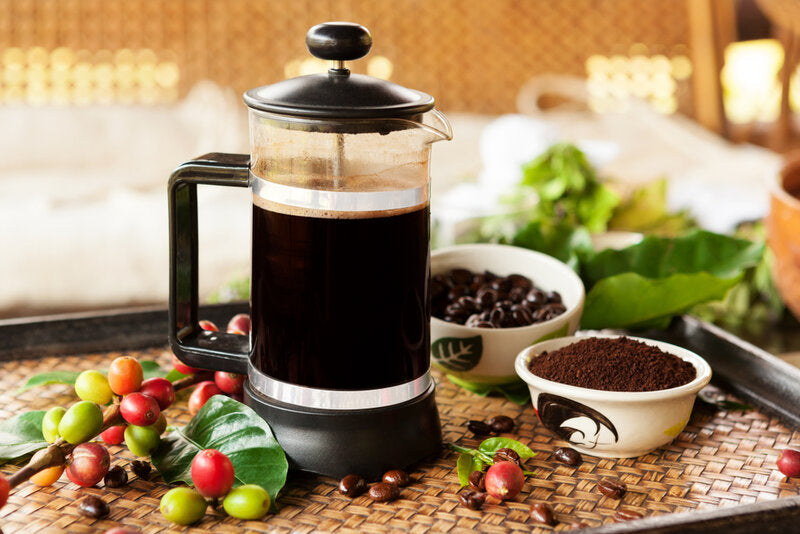
How to Make an Amazing Plunger Coffee
Share
One of the most well known but possibly most underrated brewing methods is the classic plunger coffee. It uses a style called immersion brewing where the coffee sits in hot water extracting for an amount of time before being strained and served. This style is a more forgiving and simpler technique than using an espresso machine or even pour-over coffee.
However, that does not mean that the end result has to be any less amazing. With more focus in recent years being directed to quality of coffee you can use things such as single origin coffees in your plunger to create something really special.
Recommended equipment
- Coffee Plunger (or french press)
- Digital Weighing Scale
- Timer/stopwatch
- Kettle
- Fresh coffee beans
- Coffee grinder
- Water
- Your favourite mug
How to Make Plunger Coffee?
Preparation
First of all bring the water to a boil in your kettle in preparation. It is not recommended to add freshly boiled water directly to the coffee beans because you will over extract your brew and end up with a bitter cup. Therefore it is recommended to let your kettle sit for a minute or two after boiling before starting your brewing methods.
Alternatively, if you have a smart kettle you can set your kettle to a specific temperature below boiling to add more control to your brew. This is a value you can experiment with depending on how you would like to change the flavor of your resulting cup, we recommend a starting point of 93 degrees celsius.
Once your kettle has boiled it is good practice to pour the boiling water into your empty plunger. This will preheat your plunger, preventing the room temperature plunger from dropping the temperature of your brew water once coffee is added. Once the plunger is preheated discard the water, or use it later to water your plants.
Add your Coffee
With an empty preheated plunger you can now add your coffee. For best results use freshly roasted and freshly ground coffee, this is possibly more important than any other step. The amount of coffee you use will depend on your own taste and how much of a kickstart you need in the morning. As a guide it is recommended to use 60-70 grams of coffee for every litre of water, then add a bit more next time if it tastes a bit too watery.
If you are able to freshly grind your coffee we would recommend a medium to a coarse grind. A finer grind will give you a higher extraction however with a french press it is important to not grind too finely. This may cause coffee grounds to easily bypass the mesh filter causing a bitter and gritty feel in your mouth. A way to monitor this is to check how much fine coffee grounds remain at the bottom of your cup.

Add your Water
Now it’s time to add your water. As mentioned previously it’s best not to add boiling water directly to the coffee so if the kettle has just finished boiling let it cool for one to two minutes. With the strainer removed from the plunger add your water. Pour the water with the goal to wet all the grounds before all the water is added.
Now let the coffee sit for one to two minutes with the lid placed on the plunger but not plunged. This helps maintain the water temperature giving you a better extraction. You may notice that a large portion of the coffee has floated to the top of the water. This happens when gasses from fresh coffee are released by the addition of water carrying the grounds to the surface. However after one to two minutes of adding the water, gently stir the surface of the grounds helping the coffee to fall from the surface into the water to be extracted more evenly.
Wait…
Now it’s time to place the lid back on and wait. The brew time can depend on the brew method ranging anywhere from 4 to 8 minutes to brew. As you wait the hot water will be pulling out more flavor from the coffee while also allowing finley ground pieces of coffee suspended in the water to settle to the bottom with the rest of the coffee, therefore not ending up in your cup. We recommend waiting more towards 8 minutes if you have the time and patience but be aware that this may create a cup of coffee that is slightly too strong or bitter for your taste.
Plunge!
Finally we get to plunge the plunger! Plunge slowly and steady to avoid stirring up the bed of coffee, reintroducing fine particles into the cup that we waited so patiently to avoid. Then while holding the lid of the plunger pour gently into your cup again trying to avoid introducing any fine particles into your cup.
Final thoughts
With this guide we hope that you are inspired to have another go at brewing some great plunger coffee or even trying something a little different with your usual method to create something great. Looking to elevate your plunger game? Check out The Artisan Barista range including a stylish fast boiling temperature controlled kettle to hone in on getting the best results from your brew every time!
